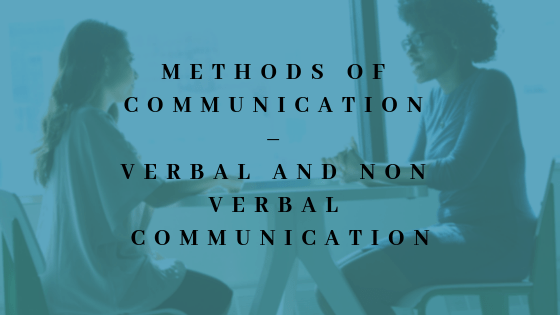It is very important to understand the communication methods to convey your message correctly to other party, we are going to discuss some of the very important methods of communication like, verbal communication, oral communication.
Verbal Communication Methods
It is communication in which sender and receiver lie on pre-determined and standard ways of encoding and decoding.
Verbal communication is not possible in the absence of language. Verbal Communication is the dominant method of communication due to the highest reliability and effectiveness.
Oral Communication
For any organizational or non-organizational communication, words are the most important symbol.
In an organizational setting, most of the employees spend more than 50 percent of their time in some form of oral communication.
To communicate orally is very easy. Oral communication is useful, and you get instant feedback while expressing. However, there are some demerits also such as lack of proof, lack of authenticity and it is also very time-consuming.
Written Communication
There may be a suggestion system or dairies where written communication use. Written communication is in the form of a letter, circular or note.
With the invention of the internet, instant written communication facilitated.
There are authenticity and proof of future reference in written communication. However, it proves to be costly as well as there is a lack of secrecy.
Non-Verbal Communication Methods
Non-verbal communication is very crucial in both organizational as well as non-organizational settings. It does not include speech or any word spoken by the person.
A body movement may not by itself have a precise or universal meaning, but when linked with words, it may convey the correct sense.
Sometimes there may be a contradiction between verbal and non-verbal communication. Action speaks louder than words in the long run.
A manager who says one thing but acts differently will have less credibility, and his team will focus less on what he says.
“Credibility gap” may be defined as the difference between what one says and what one does.
Body Language
Body language is the conscious and unconscious movements and posture by which attitudes and feelings communicated.
It plays an essential role in communication. Some estimates disclose that speech only makes up about 20 to 30 percent of communication and rest depends upon the body posture.
In other words, body language known as ‘kinesics.’ Body language includes gestures, postures, head or it can also be the whole body.
Para-Linguistic
It is a kind of area of non-verbal communication that emphasizes body language.
It may define as the vocal features that supplement speech and add to communication but are not generally acknowledged to be part of the language system.
The capability to interpret para-language correctly consider as an important competency in both personal and professional settings.
Paralanguage is also known as Para linguistic. Various aspects of paralanguage include posture, eyes, hand movement, voice and more.
For example, Finnish is relatively slow speaking as compared to European languages. It mainly refers to a non-verbal mode of communication, which is used to modify meaning and emotions.
Space Language
The study of the application of distance between sender and receiver in the communication process is known as space language.
It is also known as ‘proxemics,’ every culture, country, and workplace has different space language among the members.
It is the study that explains how people treat their space and other people in their proximity. It is an essential category of non-verbal communication.
Knowing how to use your space and how others keep their space is critical in creating the right connections and leaving a good mark.
There are different zones in this kind of language, some of these are:
- Intimate zone- minimum distance touch up to 18 inches
- Personal zone- from 18 inches up to 4 feet
- Social zone- from 4 feet to 12 feet
- Public zone- from 12 feet onwards till it is audible or visible.
Sign/Symbol Language
Sign language is the most difficult of all. It is complicated to understand by an average person.
Sign language mainly uses manual communication to convey meaning, and this is almost similar to spoken but difficult to interpret.
Sign language should not be confused with body language, which is a kind of non-linguistic communication.
Advantages of Verbal Communication
- Greater reliability and effectiveness
- Less time taking
- Economic
- A universal language
- Easiest form if you know the language
Disadvantages of Verbal Communication
- No secrecy
- Complex
